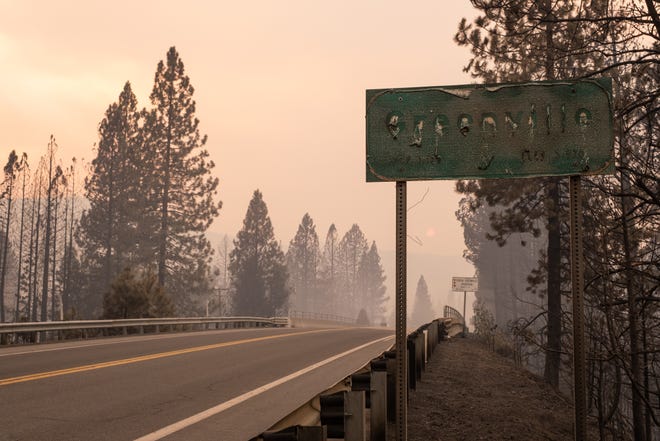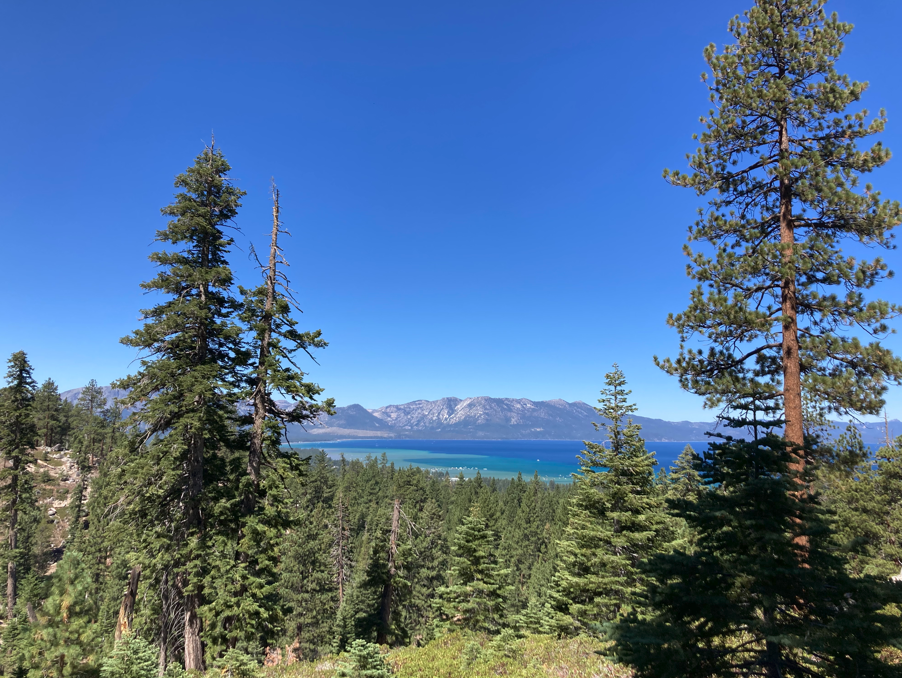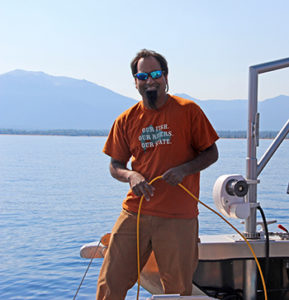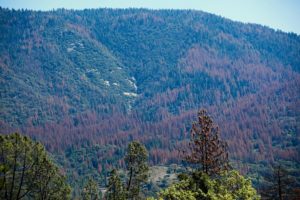A trail should dance in harmony with the landscape. That harmony is under threat and impacts planning and long term decision-making for how to make the Tahoe Rim Trail (TRT) safe and sustainable so it can last for future generations. The current climate crisis has impacted the way a trail user of the TRT experiences the landscape and the ability for trail crews to access and maintain the TRT system. Lake Tahoe is a great example of the mass change that is not just taking place in California or Nevada, but globally.
A grim global report on climate change released on August 9th, 2021 paints a dire picture for the future of Earth. Dubbed a “code red for humanity” by the United Nations, the report says unequivocally humans have caused climate change, driven up greenhouse gas emissions and led to warmer weather.
 A road sign that reads Greenville, burned by the Dixie Fire, stands on the side of Highway 89 on August 8, 2021 in Greenville, California. (Photo by David Odisho/Getty Images)
A road sign that reads Greenville, burned by the Dixie Fire, stands on the side of Highway 89 on August 8, 2021 in Greenville, California. (Photo by David Odisho/Getty Images)
There are numerous ways in which climate change and human recklessness are altering the Tahoe Basin and more specifically, the experience of hiking the TRT.
Decreases in snowfall and annual runoff due to declining precipitation will most likely result in lakes within the Tahoe basin reaching consistently lower levels. There will also be damage done to native fish species, such as the federally threatened Lahontan Cutthroat Trout, which relies on ample water within local creeks and rivers for it to be able to migrate between large bodies of water, such as Lake Tahoe and Pyramid Lake. As droughts will most likely continue to intensify, the effects of climate change will become more prominent. Local communities such as Reno, will most likely resort to relying more heavily on Lake Tahoe for a reliable water source, and to maintain what is considered a normal lifestyle. Some water sources that are encountered by hikers on the TRT may dramatically lose a large portion of outflow or dry up completely.
View of low water levels from the TRT on the K2K South Shore Trail

The increase in water temperatures of Lake Tahoe will also invite and contribute to the spreading of other environmental issues.
The large increase in algae growth is one topic that has gained attention locally and nationwide. As water temperatures continue to increase, species of non-native algae’s, such as Curly leaf Pondweed and Eurasian Water Milfoil will continue to expand within the lake while also depleting nutrients from the soil. Many visitors relate this issue to the construction of the Tahoe Keys, the rising of temperatures, and the presence of invasive species on boats foreign to the lake. The spreading of algae may also prove to be visually unpleasing to visitors of the Tahoe Rim Trail, and could present some barriers to recreational activities, such as fishing and swimming. Dead fish may also be commonly found on shore in areas with high algae blooms and low oxygen levels.

Co-author and Professor Sudeep Chandra at the University of Nevada, Reno studying algal blooms
As the climate within the Tahoe Basin continues to warm, the mixing of the lake’s water will also see a decrease. The process of water mixing is often associated with the manner in which the lake receives oxygen, specifically the deepest parts of the lake. The abundance of oxygen is another factor that contributes to the fantastic water quality and clarity of Lake Tahoe, and other alpine lakes. As sediments and nitrogen from sources such as motor vehicles continue to enter the lake, Tahoe’s oxygen levels will continue to decrease as well. The increase of tourism over the years and the carbon emissions emitted by both cars and boats are quickly changing the basins’ air and water quality.
The unprecedented weather we’ve experienced in the Tahoe region has come to a head recently with the Tamarack, Dixie, and other wildfires. Smoke, ash, and soot not only affect air quality, but can also alter water quality within the lake and living standards. California’s fire season, along with local fire warnings should be factors that Tahoe Rim Trail visitors need to consider when planning their journey along the trail during fire season summer months (Late June to mid-August is California’s peak fire season). Unless winds are fairly active, smoke has the tendency to linger within the basin and present unhealthy conditions. The current climate crisis may mean an earlier and longer fire season that Tahoe Rim Trail users will need to account for, especially those with pre-existing health conditions.
The Dixie Fire, which has incinerated more than 482,047 acres (as of August 10th, 2021), is one of the largest recorded wildfires in state history and remains only 22 percent contained. A prolonged wildfire season could drastically change assess to the TRT and planning for backcountry and day hiking trips. The ramifications might mean planning longer trips in the early spring or late fall to avoid wildfires.
As an attempt to combat large wildfires, the U.S. Forest Service has begun thinning some forests in an effort to proactively assure that some regions aren’t affected. While these measures are effective and appreciated for their level of fire prevention, some hikers of the TRT may find some landscapes within the basin barren, shade-less, and lacking in vegetation and wildlife. Hopefully these actions will result in healthier forest for years to come, and ultimately a better experience for those out exploring the Tahoe Basin’s natural beauty. It is projected that between 2012 and 2016, the Sierra Nevada region had lost around 129 million trees due to unhealthy conditions, fires, and human disruption.

Photo depicting tree mortality in the Sierra Nevada
Increased drought throughout the region has also resulted in a number of tree species becoming susceptible to invasive insects and pathogens, which can often weaken and kill trees. Trees in this region are most often affected by the invasive Mountain Pine beetle and a fungus named White Pine Blister Rust, which has eliminated a large majority of Sugar pine trees from the Tahoe basin. Native tree species in the Tahoe Basin help sequester carbon dioxide, so the combination of pests and pathogens with longer droughts, eliminates the pivotal role they play in the fight against climate change along with the habitat they provide for key wildlife species.
While it can be daunting to recognize the environmental issues that the planet and our region are facing, there is still optimism that we can overcome this adversity and bring a sense of stewardship and responsibility while out in nature. With increased visitation may come the need for greener infrastructure and an increase in modes of transportation like electric cars and biking. This may also mean putting limits on the amount of people allowed in certain popular areas like Desolation Wilderness, or creating an eco-friendlier transportation system in the region that makes driving to certain segments of the Tahoe Rim Trail less of a necessity. We encourage all Tahoe Rim Trail explorers to set an example for generations to come, and to be the model that other areas of the country can point to when speaking on ideal trail etiquette.
Sources
- (UC DAVIS ) https://tahoe.ucdavis.edu/climate-change
- (The Californian Aggie) https://theaggie.org/2019/12/02/reforestation-of-sugar-pine-trees-in-lake-tahoe-basin/
- (KNPR)https://knpr.org/knpr/2021-04/lake-tahoe-invasive-species-problem-and-plans-solve-it
- (Reno Gazette Journal) https://www.rgj.com/story/life/outdoors/2017/08/10/how-climate-change-harms-lake-tahoe-and-how-stop/558083001/
- (SF GATE) https://www.sfgate.com/renotahoe/article/Lake-Tahoe-drought-water-drops-two-feet-16169540.php


